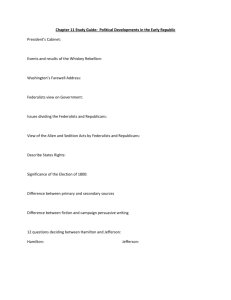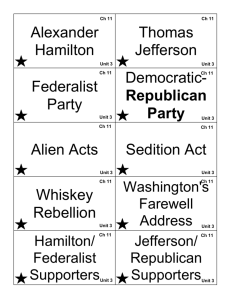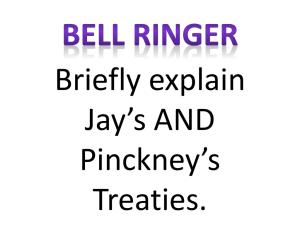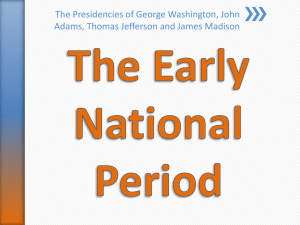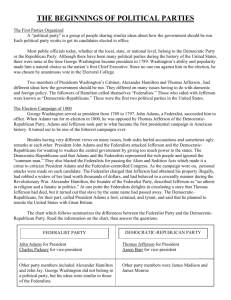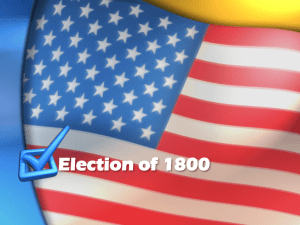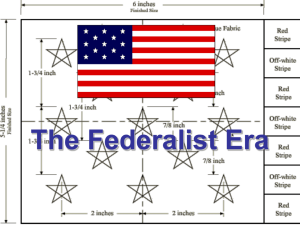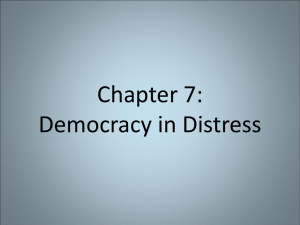Chapter 10: Launching the New Ship of State
advertisement
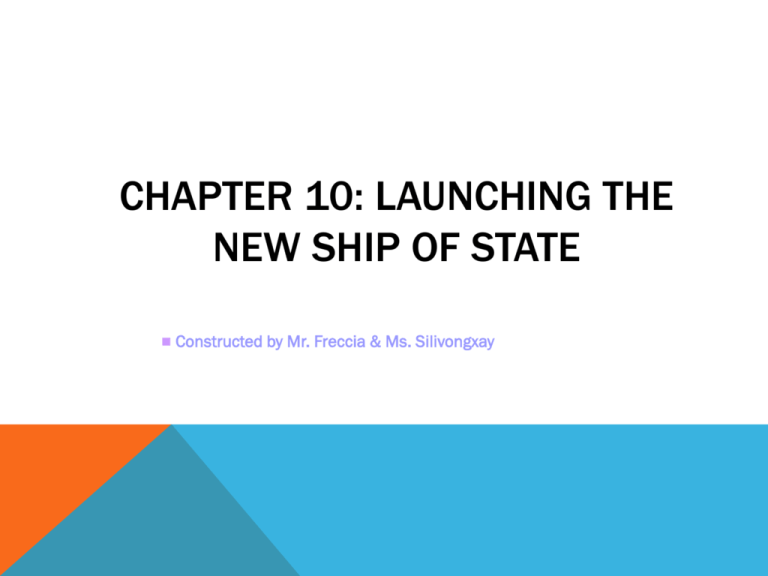
CHAPTER 10: LAUNCHING THE NEW SHIP OF STATE Constructed by Mr. Freccia & Ms. Silivongxay DIRECTIONS Take Cornell notes. Make 15 questions over notes. Remember to condense information down otherwise you will not be able to keep up. Make sure you take notes over the embedded videos. Don’t forget to do the summary at the end of your notes. Make sure you read the full notes for chapter 10.Turn this end tomorrow! GROWING PAINS After 12 years of government-disabling, now America had to begin nation-building. During the Revolutionary time period though, a strong distrust of government had been instilled in people. The U.S. financial situation was grim. Revenue was very small yet the debt was mounting due to interest. Hard (metal) money was scarce and the paper money was worthless. The financial situation was the number 1 problem the new nation faced. Still, America was trying to create a democracy on a scale never been done before and make it fly. GROWING PAIN CONTINUES The U.S. Constitution went into effect in 1789. The population was doubling every 20 years. The largest cities in the 1790 census (in order) were Philadelphia, New York, Boston, Charleston, and Baltimore. 90% of the people were rural. 5% lived west of the Appalachian Mountains. These folks lived mostly in Kentucky, Tennessee and Ohio which soon became new states. New Hampshire had already become state number 14. WHY BILL OF RIGHTS? All thirteen states had to ratify the Constitution Nine states needed to “reset” the country, canceling out the Articles of Confederation Conservative document that prevented the “mob” from controlling government Was a surprise to the public ANTI-FEDERALISTS VS. FEDERALISTS Anti-Federalists States’ rights Backcountry dwellers Small farmers Debtors S. Adams, P. Henry, Richard Henry Lee Federalists Strong federal gov. Seaboard dwellers Wealthy and better educated Controlled the press (The Federalist Papers) G. Washington, B. Franklin, Madison, Hamilton, John Jay ELECTION OF 1789 Electors cast two votes for President Each elector selected Washington w/ at least one NC and RI hadn’t ratified the Constitution NY had problems deciding how electors would be chosen Executive Branch (1789-1796) George W ashington President John Adams Vice-President Thom as Jefferson Secretary of State Alexander Ham ilton Secretary of the Treasury Henry Knox Secretary of W ar • Cabinet not outlined in the Constitution – a “Washington Invention” • John Jay named 1st Chief Justice of the five member Supreme Court •http://www.youtube.com/watch?v=dwW8BD3nP44&feature=related CONGRESS AT WORK… James Madison sought to protect the Constitution and win over “the anti-Feds” What he develops becomes known as the Bill of Rights (he is the “father of”) One of the first acts done by the new Federal Government Judiciary Act (1789) organizes the Supreme Court ALEXANDER HAMILTON Not a “natural” citizen (born in the Caribbean) Federalist / aide to Washington Arch rival: Jefferson “Father of the National Debt” Assumption fight and compromise Debt was a “national blessing” Bank of the United States http://www.youtube.com/watch?v=M QVRUZFM8Iw&feature=related NATIONAL DEBT STRUCTURE Debt owed to Foreigners $11,710,000 Federal Debt $42,414,000 State Debt $21,500,000 Miscellaneous Revenue Customs Duties (tariffs) Excise Revenue (Whiskey, etc.) WHISKEY REBELLION (1794) PA farmers not happy with tariff Launch an “insurrection” Washington personally leads militia into PA to restore order (direct opposite of Shay’s Rebellion) Represents peaceful dialogue over violence in order to change policy http://www.youtube.com/watch?v=RL1UE5nzcs&feature=related WHAT CAUSED PARTIES TO FORM? POLITICAL RIVALRIES Democrat-Republicans States rights (local) Strict construction view Agriculture based Rule of the people Backed France Support in S and W Jefferson and Madison key supporters Federalists Federal rights Loose construction view Industrial based Avoid “mob” rule / elites Backed England Support in NE J. Adams and Hamilton key supporters WASHINGTON’S FAREWELL ADDRESS Beware of entangling alliances… …because they will get us involved in other people’s wars. RATING THE PRESIDENTS More notable American rather than President Extremely popular at the time Sets the bar for what a Pres. does Foreign policy of neutrality Prevents a “backslide” of revolutionary ideals ELECTION OF 1796 President and V.P. come from different parties for 1st time MD split the vote between the two Other candidates vote count not depicted PRESIDENT JOHN ADAMS Jay’s Treaty with England angers D-R and France. Adams not well liked and comes to power in a very close, bitter election Stuck between neo-Federalists led by Hamilton (not pro-British enough) and Jefferson’s D-R (anti-British) France reacts by seizing American vessels at sea (300 by 1797) QUASI-WAR W/ FRANCE (1798-1800) John Marshall is sent to France to negotiate w/ Talleyrand QUASI-WAR BROUGHT TO YOU BY THE LETTERS X, Y, AND Z They ask for a $250,000 bribe just to talk to Talleyrand Marshall refuses and returns to America “Millions for defense, but not one cent for tribute” Adams avoids war by appealing to new French ruler Napoleon Convention of 1800 = “divorce” w/ Fr. http://www.youtube.com/watch?v=afB5NJmER5M ALIEN AND SEDITION ACTS Federalists during war fervor pass laws to silence the opposition (D-R) Alien Act Naturalization from 5 to 14 yrs President can jail or deport in time of war Sedition Act Impeding policies of the government = jail Attacking officials in press = jail and fine http://www.youtube.com/watch?v=I9kCvBZGzXc&featur e=related VIRGINIA AND KENTUCKY RESOLUTIONS It was a protest against the Alien and Sedition Acts of the Federalist Jefferson writes for Kentucky Madison writes for Virginia Develops the idea of “nullification” The States have the right to ignore laws that the Federal Government “oversteps it’s authority on” Constitutional issues were later a right the Supreme Court “adopts” in 1803. ELECTION OF 1800 By the election of 1800, there were clearly two separate political camps in the U.S. Federalists Versus Democratic-Republicans. http://www.youtube.com/watch?v=Y_zTN4BXvYI http://www.youtube.com/watch?v=MQVRUZFM8Iw&feat ure=related FEDERALIST Federalists were supported by the upper classes. Generally speaking… They were led by Hamilton who envisioned an industrial America of big cities. They were from the wealthy classes, such as merchants, bankers, manufacturers. They often lived along the eastern seaboard—the older regions that were close to the coast and trade. They were pro-British (since that was good for trade). They liked a strong federal government, run by the educated elite. They distrusted the common person as uneducated and unable to run a nation. They felt democracy was one step shy of "mobocracy." DEMOCRATIC-REPUBLICAN The Democratic-Republicans (or just Republicans at this time) were supported by the poor and common classes. Generally speaking… They were led by Jefferson who envisioned an agricultural America of small towns. They felt that even an uneducated man can make common-sense decisions and thus run himself and his nation through voting. Republicans favored expanding the vote to more people (though it was still a very narrow group). They were mostly farmers and lived in the interior areas and along the frontier. They felt farming was good for the soul—it kept the farmer humble and close to God. They were pro-French (since France had helped the U.S. against England). RATING THE PRESIDENTS John Adams (Federalist): More notable American rather than President Extremely disliked at the time / abrasive personality Doesn’t get caught up in war fever and does what was best for the country Splits his party and loses in close election to Jefferson (Republican)
